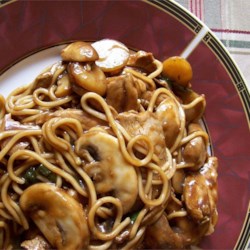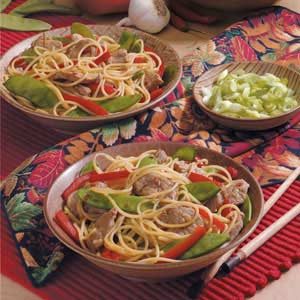Source(google.com.pk)
Traditionally, Lo Mein is a popular noodle style in Hong Kong where noodles are boiled, drained and then stirred in with clear broth or on the side or with a house special soy sauce. The ‘stirred noodles’ are served with vegetables, wontons, and meats such as BBQ pork, Cantonese beef stew, etc. However, the popular chinese take-out Lo Mein here in America is a whole other version. American-chinese Lo Mein is prepared with boiled noodles, and then stir-fried with vegetables, meat, etc. in a house special sauce, and MSG laden.
A personal house special Lo Mein can be as easy and flexible as you want it to be. Simply put, use fresh noodles, or spaghetti, your choice of protein, or seafood and vegetables, a light sauce, smoky hot wok, and there you go – a healthy yet delicious home-cooked Lo Mein. My favorite Lo Mein dish has always been Chicken Lo Mein. Noodles tossed in light sauce, and then cooked with chicken broth. For added flavor, mix in some chinese mushroom and some seasonal vegetables.
Chicken Lo Mein is one of the most popular take-out items you can find on the menu of Chinese restaurants worldwide. But of course if you are not in that much of a rush to get your noodle fix, you will find that it is such a simple dish to prepare at home and such a joy to customize it to your own liking.
Oyster sauce (Recipe: chicken lo mein)
The walking route from our first apartment in Boston to my job at a publishing company in the Leather District took me right through Chinatown.
I didn't know how to cook, so the temptation was minimal.
Every day I walked past half a dozen markets, some with produce spilling into the street, others that sold only noodles, or barbecued duck suspended in the window. I never stopped at the bakery that made moon cakes and fortune cookies. I passed up the housewares and cookware.
Seriously.
Today it takes me hours to cover the same few blocks I used to speed through in minutes. And I come home lugging fresh and dried noodles, bamboo steamers, every imaginable variety of choy (greens) and chile peppers, and bottles of condiments, like my very favorite oyster sauce.
Asian cooking is all about condiments: authentic condiments, authentic taste; imitation condiments, not much taste. Oyster sauce (also called oyster-flavored sauce) is a thick, salty, but not fishy-tasting sauce made from boiled oysters and seasonings. True oyster sauces are oyster extracts, without anything added, but most versions -- the ones whose flavor we recognize from Chinese restaurant dishes -- contain cornstarch, caramel, and other flavorings that yield a rich, dark brown sauce.
We think of China as an ancient culture, and of Chinese food as an ancient cuisine, but oyster sauce is a "new" condiment, invented in the 1880s by accident. After Nixon's visit to China in 1972, the Lee Kum Kee company, capitalizing on the popularity of the panda as a symbol of friendship between the US and China, created Panda Brand oyster sauce, a lower-priced version of their premium sauce, specifically for export to overseas Chinese communities.
Many brands, including Panda, do contain MSG. I'm often sensitive to MSG, but the tiny amount in this sauce doesn't seem to bother me.
Once opened, oyster sauce should be stored in the refrigerator, and will keep for a year or more.
Of course I use oyster sauce in stir fry dishes; it adds richness to beef or chicken, vegetables, or tofu. I always add a bit to salmon fried rice and to Ted's favorite beef stew, too, and I mix it with light soy sauce and rice wine as a dip for tempura or nime chow.
And it's the "2" in the 3-2-1 Cantonese and Szechuan Trinities, my basic all-purpose stir-fry sauces.
Chicken lo mein
One of my all-time favorite restaurant-style dishes, this recipe serves 6.
Ingredients
1 lb fresh Chinese egg noodles (or use dry spaghetti)
2 tsp peanut or canola oil
1 lb boneless, skinless chicken breast, cut into bite-size pieces
1 small onion, diced, or 4-5 scallions, chopped
1 clove garlic, peeled, sliced thin
4-oz can sliced mushrooms
1/2 cup Cantonese 3-2-1 sauce (3 parts reduced-sodium soy sauce, 2 parts oyster sauce, 1 part sesame oil), or more as needed
2 cups mung bean sprouts (optional), rinsed under cold water
Directions
Bring 6 quarts of water to a boil; cook egg noodles over high heat until they float to the surface, then reduce heat and cook for 2-3 minutes until al dente (or cook spaghetti according to package directions). Drain, but do not rinse, and reserve the cooking water.
In a large wok or frying pan, heat the oil. Add the chicken and stir fry for 1-2 minutes, until lightly brown all over. Add the onion, and stir for 1-2 minutes, until translucent. Add the garlic and mushrooms, and stir for 1 minute. Add the Cantonese 3-2-1, plus 1-2 tablespoons of the reserved cooking water, and stir for 1 minute until the meat is coated. Add the cooked noodles and bean sprouts, and stir thoroughly for 2-3 minutes, until the ingredients are combined and the sauce is absorbed into the noodles. If needed, add more soy sauce and oyster sauce, to taste.
The main difference between lo mein and chow mein lies in what happens to the noodles before they are combined with the other ingredients. In chow mein, the noodles are fried separately. Usually, the fried noodles are combined with the meat, vegetables and other ingredients in the wok at the end of cooking.
Noodles destined for a dish of lo mein skip this separate frying stage. In fact, the noodles may not undergo any further cooking at all: it is common to serve the parboiled noodles in individual bowls at the table and pour the other ingredients over top. Alternately, the noodles may be quickly tossed with the sauce and other ingredients in the wok before serving.
Since the real star of any lo mein dish is the sauce, it's not surprising that Lo Mein recipes often use more sauce than chow mein recipes. Frequently, the sauce is thickened with a cornstarch and water mixture before being combined with other ingredients
Chinese Lo Mein Recipe Chinese Recipes With Chicken by Chef Zakir For Kids Soup Images In Urdu Chicken Shashlik Bitter Gourd Urdu Fish Authentic

Chinese Lo Mein Recipe Chinese Recipes With Chicken by Chef Zakir For Kids Soup Images In Urdu Chicken Shashlik Bitter Gourd Urdu Fish Authentic
Chinese Lo Mein Recipe Chinese Recipes With Chicken by Chef Zakir For Kids Soup Images In Urdu Chicken Shashlik Bitter Gourd Urdu Fish Authentic

Chinese Lo Mein Recipe Chinese Recipes With Chicken by Chef Zakir For Kids Soup Images In Urdu Chicken Shashlik Bitter Gourd Urdu Fish Authentic

Chinese Lo Mein Recipe Chinese Recipes With Chicken by Chef Zakir For Kids Soup Images In Urdu Chicken Shashlik Bitter Gourd Urdu Fish Authentic

Chinese Lo Mein Recipe Chinese Recipes With Chicken by Chef Zakir For Kids Soup Images In Urdu Chicken Shashlik Bitter Gourd Urdu Fish Authentic

Chinese Lo Mein Recipe Chinese Recipes With Chicken by Chef Zakir For Kids Soup Images In Urdu Chicken Shashlik Bitter Gourd Urdu Fish Authentic

Chinese Lo Mein Recipe Chinese Recipes With Chicken by Chef Zakir For Kids Soup Images In Urdu Chicken Shashlik Bitter Gourd Urdu Fish Authentic

Chinese Lo Mein Recipe Chinese Recipes With Chicken by Chef Zakir For Kids Soup Images In Urdu Chicken Shashlik Bitter Gourd Urdu Fish Authentic

Chinese Lo Mein Recipe Chinese Recipes With Chicken by Chef Zakir For Kids Soup Images In Urdu Chicken Shashlik Bitter Gourd Urdu Fish Authentic

Chinese Lo Mein Recipe Chinese Recipes With Chicken by Chef Zakir For Kids Soup Images In Urdu Chicken Shashlik Bitter Gourd Urdu Fish Authentic
No comments:
Post a Comment